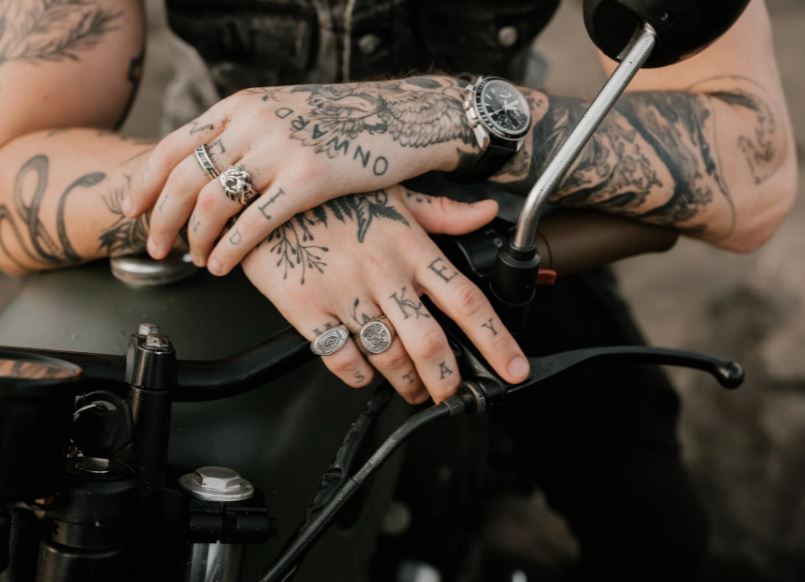Today, tattooing has become a common, everyday phenomenon: one in four Americans has at least one tattoo. But this phenomenon has gone from body art to a huge tattoo industry, with modern, advanced equipment. Moreover, we now have access to much less painful ways of tattooing (in particular it became so with the advent of rotary tattoo machines). Let’s take a closer look at the topic of the history of the emergence and spread of tattoos, starting with the information we know about the first examples of body art in history.
The World’s First Tattoo
The history of tattoos is believed to date back nearly 10,000 years. They have been found in a number of human cultures on every continent. Tattoos were particularly popular amongst the Ainu people (an indigenous people of Japan) who wore facial tattoos that could indicate their social status, age, or even marital status. The Ainu people in Japan also wore traditional costumes that are designed with interesting and unique art. Find out more about this in our article, How Does Ainu Clothing Reflect the Unique Culture of Japan’s Indigenous People?
Dates for the first tattoos are difficult to determine as they were typically not recorded. However, the oldest tattoo ever discovered was found on a mummy in the Alps and is estimated to be over 5,300 years old.
The first tattoos were likely invented by accident. Someone may have been scratched with a bit of charcoal or a sharp object and the wound may have become infected. The person would then have noticed that the infection produced a dark blue or black mark on the skin.
How Did Tattoos Spread?
Tattoos are spread by word of mouth and through contact with other cultures. They were often used to identify members of a tribe or to commemorate special occasions.
At first, only tribal elders could wear tattoos as they were often used for ceremonial purposes. But as time passed and tattooing techniques improved it became easier to tattoo others, such as those who had undergone the rite of passage ceremonies.
Tattoos began to spread throughout other parts of the world as explorers and missionaries encountered new cultures with their own tattoo customs.
How Did Tattoos Change?
Tattooing increased in popularity as tattoo machines were introduced in the 1800s. In 1846, artist Martin Hildebrand introduced the art of tattooing to America. It was he who in 1870 opened the first tattoo parlor in New York.
In 1891, Samuel O’Reilly patented the first electric tattoo machine. This invention made tattooing much easier and faster compared to hand-poking with needles. Using the Handpoke technique, even the most experienced artists can pierce the skin 2-3 times per second at most. With his machine, it could already be done about 50 times. It was not long afterward that tattoos became a fad in Europe and America. Samuel O’Reilly’s invention brought him fame and revolutionized tattooing.
Tattoos have evolved from being a sign of belonging to a tribe or a rite of passage into an art form that people get for various reasons. The first documented modern instances of tattooing as we know it today took place during World War II on some soldiers, sailors, and Marines; they would get tattoos as a sign of commitment to their unit and to commemorate battles and other tattoos they got before entering the service.
The Ainu people in Japan, particularly women, have unique tattoos that showcase their history and life. Find out more about them in our post, What Are Traditional Ainu Tattoos?
Women Tattoos
Tattoos were once mainly worn by men, but today women are also getting tattoos in increasing numbers. The first documented instances of female tattooing were done in ancient Egypt when they weren’t considered to be taboo or something that was unacceptable for women.
Nowadays
Today, there are people who get tattoos as an expression of love for someone or as a way to pay tribute to those who have passed away. We now also see tattoos as a fashion trend with pop stars such as David Beckham sporting tattoos.
What Were Early Tattoos Made Of?
Early tattoos were made from a variety of materials, including charcoal, ash, soot, and blood. In some cases, tattoo artists would use dyes made from plants, berries, or insects.
What Meanings Did Tattoos Have?
Tattoos could have a variety of meanings, depending on the culture in which they were used. In some cases, tattoos were used as a rite of passage for those who had completed their mission. For example, the women of Samoa would wear tattoos made from soot and coconut oil if they had succeeded in planting and tending to a garden.
Final Words
The history of tattoos has come a long way since the first known examples of body art in history. But their roots are clear – they began as symbols of belonging to a tribe or clan, became part of rites of passage, and were mainly used by men. Today, people can get tattoos for various reasons, not just to express their heritage.
Tattoos have a long history, and in Japan, they are known as Irezumi. What Is the Cultural Significance of Irezumi in Japan? explores how these tattoos are more than just body art, showing important parts of Japanese culture and beliefs.
